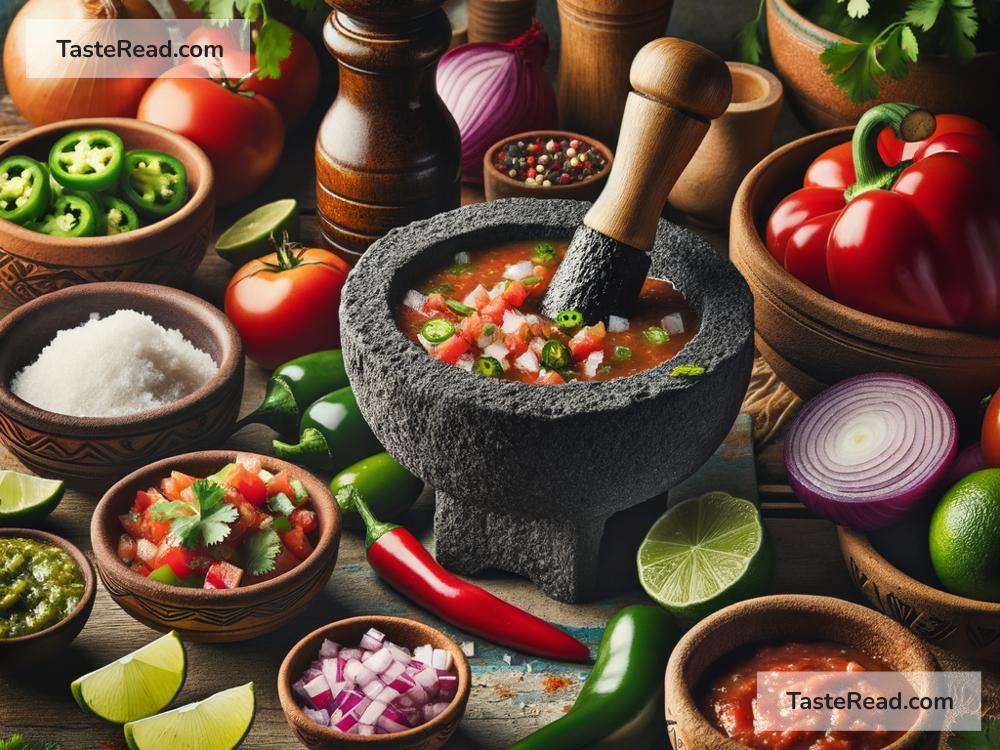The Story of Mexican Salsa: A Tale of Flavor and Tradition
Salsa is one of Mexico’s most famous contributions to the world. It is a flavorful sauce that brings life to many dishes, from tacos and enchiladas to tortilla chips. But salsa is more than just a condiment; it tells a story of history, tradition, and the love Mexicans have for food. Let’s explore the story of Mexican salsa and learn how it became a symbol of Mexican cuisine.
The Origins of Salsa
The word “salsa” simply means “sauce” in Spanish. Its history dates back thousands of years, long before Mexico even existed as a country. The Aztecs, Mayans, and other ancient civilizations would make sauces by grinding fresh ingredients together. They used tools like the molcajete, a stone bowl similar to a mortar and pestle, to mash tomatoes, chiles, and other items for their meals. These early versions of salsa were not just for flavor—they were also used as a way to preserve food and add nutrients.
Tomatoes and chili peppers, the main ingredients in salsa, are native to Mexico. These plants have been growing there for thousands of years. Corn, beans, and chilies formed the backbone of Mesoamerican diets, and salsa was often created to enhance these staples. The ancient people of Mexico valued spicy and tangy flavors, which continue to define Mexican cuisine today.
Salsa’s Journey Through History
When the Spanish arrived in Mexico in the 1500s, they brought new ingredients with them, such as onions, garlic, and cilantro. These blended with the native ingredients to create flavors that became the foundation of modern Mexican cooking.
Over time, salsa recipes evolved as different regions of Mexico adapted them to their local tastes and available ingredients. For example, salsa verde (green salsa) uses tomatillos instead of red tomatoes, creating a tangy, bright flavor. Salsa roja (red salsa) is the classic tomato-based version, often blended with spicy chiles like jalapeño, serrano, or chipotle. Other traditional salsas include pico de gallo (a chunky mix of fresh tomatoes, onion, cilantro, and lime juice) and salsa de molcajete, a rustic salsa made by grinding roasted ingredients by hand.
As Mexican people traveled and migrated, they carried their recipes for salsa with them, spreading the love for these bold flavors around the world.
Salsa’s Importance in Mexican Culture
Salsa is more than just food in Mexico—it’s part of the culture. It brings families and communities together. Making salsa is often a shared activity, whether it’s preparing fresh salsa for a Sunday meal or making large batches for celebrations like weddings and birthdays.
Every Mexican household has its own favorite salsa recipe. Some prefer it mild, while others love it fiery hot. Some families roast the ingredients for smoky flavors, while others keep everything raw for freshness. The beauty of salsa is that there’s no right or wrong way to make it—it’s all about personal preference and creativity.
In Mexican markets, you can usually find all the ingredients for salsa piled high in colorful displays: bright red tomatoes, green chili peppers, crisp white onions, and fragrant cilantro. Many vendors also sell freshly made salsa in jars, giving locals and tourists a taste of authentic Mexican flavors.
Salsa also plays a starring role in Mexican holidays and traditions. For example, during Día de los Muertos (Day of the Dead), families prepare special meals for their loved ones who have passed away, often including dishes topped with salsa. Similarly, during Independence Day celebrations, people enjoy traditional foods like enchiladas or pozole, where salsa adds a burst of color and flavor.
Salsa in the Modern World
Salsa has come a long way from its ancient roots. Today, it’s enjoyed all over the globe. In fact, salsa has become one of the most popular condiments in the United States, often beating ketchup for the top spot!
While traditional salsa recipes are still cherished, new versions have emerged as people experiment with different flavors. For example, mango salsa combines ripe mangoes with lime, chili, and cilantro for a sweet-and-spicy twist. Avocado salsa blends creamy avocado with jalapeño and fresh herbs. These modern salsas are a testament to salsa’s adaptability and universal appeal.
Salsa has also become a symbol of Mexican identity. When people think of Mexican food, salsa is often the first thing that comes to mind. It represents the country’s vibrant flavors, rich culture, and love for celebrating life through food.
Making Salsa at Home
One of the best ways to appreciate salsa is to make it yourself. You don’t need fancy equipment or special skills—just a handful of fresh ingredients. Here’s a simple recipe for salsa roja:
- Roast 4 tomatoes, 2 chili peppers (such as jalapeño), and 2 cloves of garlic in a pan or oven until they’re slightly charred.
- Blend the roasted ingredients with ½ cup of chopped onion, a handful of cilantro, and a pinch of salt.
- Taste and adjust the seasoning. If you like it spicier, add more chili peppers.
- Serve your salsa fresh with chips, tacos, or any dish you love.
Conclusion
Mexican salsa is more than just a delicious sauce—it’s a story of history, tradition, and culture. From its ancient origins to its modern popularity, salsa has continued to evolve while staying true to its roots. It’s a reminder of how food can bring people together, celebrate life, and keep traditions alive. So next time you dip a chip into a bowl of salsa, take a moment to appreciate the history and love behind this iconic Mexican creation.


